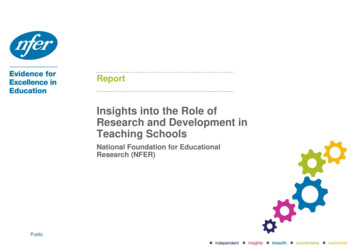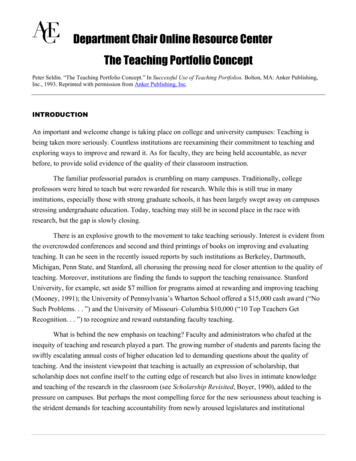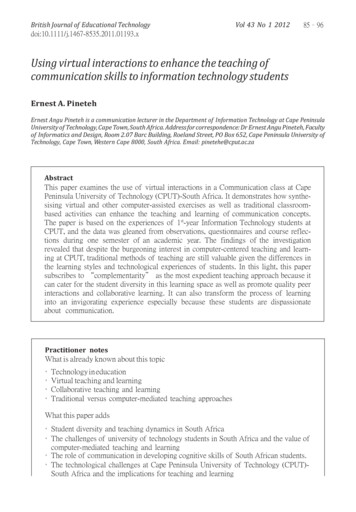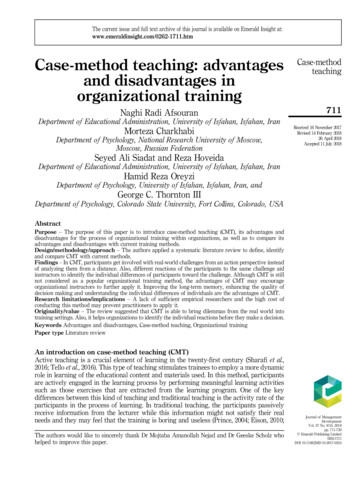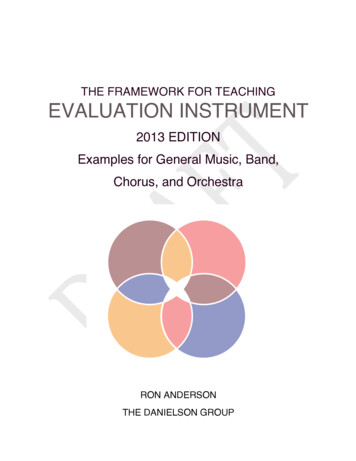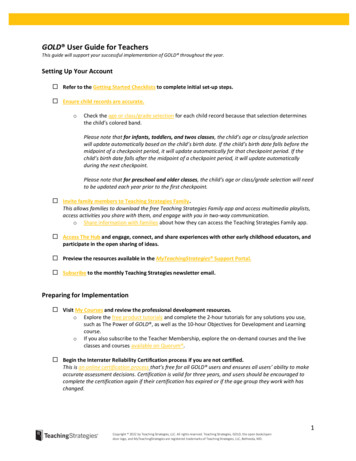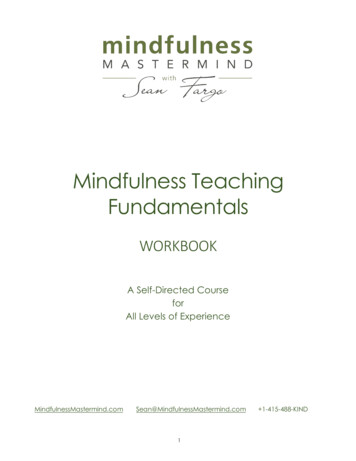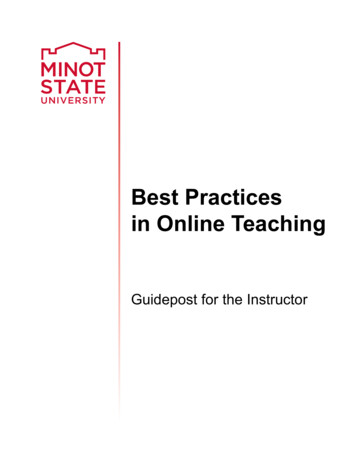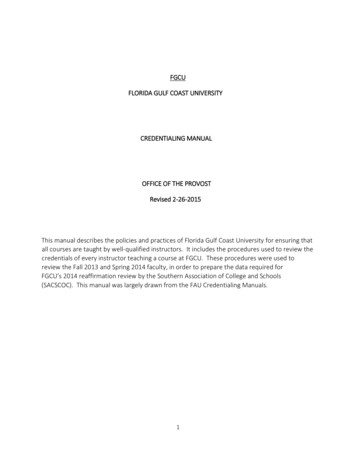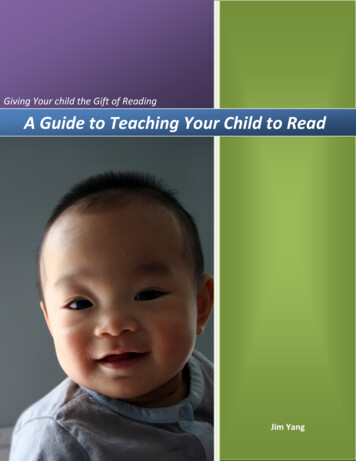
Transcription
Giving Your child the Gift of Reading[TypethecompanyA Guide to Teaching Your Child to ReadJim Yang
Teach Your Child to Read Today. VisitChildrenLearningReading.comThis is a copyrighted work of Jim Yang and ChildrenLearningReading.com. You mayfreely distribute this PDF file in its entirety; however, you may not edit it, reproducesegments from it, or offer it for sale, alone or in addition to another product.ChildrenLearningReading.com 2Copyright 2010 Jim Yang & ChildrenLearningReading.com
Teach Your Child to Read Today. en are born ready and eager to learn. They arenaturally curious about everything around them, andfrom the moment that they are born, a lifelongprocess of learning begins. Probably the mostremarkable is the development of the child's brain.Learning to crawl, walk, speak, laugh, and feel sadare all part of the brain development process. It goeswithout saying that loving care and interactions ofparents and caregivers leads to healthy braindevelopment - bonding, talking, singing, reading,and playing are some of the most key activities.These everyday moments of simple, but lovinginteractions provide essential nourishment. A child'searly experiences greatly influence how the braingrows and develops.Learning is a process that begins at birth, andcontinues throughout life. However, the brainabsorbs new information more easily and readily inearlier years of life. Young children learn easily theirChildrenLearningReading.com 3Copyright 2010 Jim Yang & ChildrenLearningReading.com
Teach Your Child to Read Today. VisitChildrenLearningReading.comnative language simply with regular exposure.Learning never stops; however, later learning isusually slower, and more difficult - just think ofwhen an adult is trying to learn a second language.Because of the great learning advantages in earlyyears of development, it is best to provide childrenwith the best opportunities for learning during theirearly years when their brain is most ready to absorbnew information, acquire new knowledge, and learnnew skills.Children learn best simply through everydayexperiences, and more importantly, when learning isfun. Forcing learning upon your child is a surefireway to turn them off from learning. Make learning afun and rewarding process, and always rememberthat different children will develop and learn atdifferent paces. Keep things simple and fun, andmake learning activities part of the lovingrelationship you share with your child.ChildrenLearningReading.com 4Copyright 2010 Jim Yang & ChildrenLearningReading.com
Teach Your Child to Read Today. VisitChildrenLearningReading.comThe ABC's of ReadingWhen does a child learn to read? Most might saykindergarten or grade one; however, I can tell youthat a child that can speak, can be taught to read,even as young as age two, as I have done for mydaughter when she was two and a half years old. I donot put much weight in the argument that onlyexceptionally smart children can learn to read at avery young age, rather, that learning to read at anyoung age is the cause which leads to the effect ofhaving exceptional intelligence later in life. As I writethis, my son just turned one year old, and I haveevery expectation that he will learn to read at ayoung age just as his sister did - when he is able tospeak.There is no shortage of studies which indicate thatearly parental involvement is critical in thedevelopment of children's reading ability. In aCanadian study conducted at the Carleton UniversityChildrenLearningReading.com 5Copyright 2010 Jim Yang & ChildrenLearningReading.com
Teach Your Child to Read Today. VisitChildrenLearningReading.comin Ottawa, researchers presented the findings of thefinal phase of a 5 year study with 168 middle andupper middle class children. This study examined therelations among early home literacy experiences,subsequent receptive language and emergent literacyskills, and reading achievement of the children.Results of this study demonstrated that a child'sexposure to books was directly related to theirdevelopment of vocabulary, listening, ment in teaching children about reading andwriting was related to the development of earlyliteracy skills, and these early literacy skills directlypredicted word reading at the end of grade one, andalso indirectly predicted reading skills in grade three.[1]Teach your child to read today using a simple, yet effective method.Please visit: ChildrenLearningReading.comHow well a child responds to reading instruction isdetermined by that specific child and their level ofmaturity. There is no simple answer to determinehow quickly a particular child learns to read. Howwell a child learns to read will also depend on therelationship established with the parent.ChildrenLearningReading.com 6Copyright 2010 Jim Yang & ChildrenLearningReading.com
Teach Your Child to Read Today. VisitChildrenLearningReading.comChildren begin to learn about language very early on,starting from the very first sounds they hear. Theyrespond to family talking and singing, and quicklybegin to understand speech although they stillcannot talk yet. Their earliest experience withwritten language usually comes when the parent orcaregiver begins to read stories to them. A healthygrowing environment with ample talking, singing,reading, and exposure to books will help to set thestage for children to become successful readers.Teaching your child to read early on will help themachieve a richer vocabulary, and be able to speakmore clearly and more coherently.Children should be seen and heard. They shouldlisten and speak often, and you should engage themin conversations to encourage them to speak. By thetime a child is one year old, they have alreadylearned a lot about spoken language simply throughtalking and listening.Why is early reading so important?In today's schools, many children struggle withreading. Not because they lack the intelligence, norbecause they have some reading disability. Rather, itis likely due to poor and inadequate readinginstructions. Reading problems for children inChildrenLearningReading.com 7Copyright 2010 Jim Yang & ChildrenLearningReading.com
Teach Your Child to Read Today. VisitChildrenLearningReading.comschool can lead to long term consequences for vation to learn, and even affect their schoolperformance. Reading achievement is critical tosuccess in school, and reading difficulties will impactevery facet of a child's academic performance. This iswhy early reading is so important.Aside from academic performance, a child who haslearned to read at an early age is able to enjoy andappreciate books of their own choice without beingdependent on adults. This reinforces their selfconfidence and self-reliance. Being able to read andcomprehend what they are reading makes anexceptional alternative to sitting in front of thetelevision. Watching too much TV can and mostoften do lead to the child relying on television as themain source of entertainment, and it becomesincreasingly difficult to develop an interest forreading.Teach your child to read today using a simple, yet effective method.Please visit: .com 8Copyright 2010 Jim Yang & ChildrenLearningReading.com
Teach Your Child to Read Today. VisitChildrenLearningReading.comFurthermore, our lives are surrounded by print, andthe ability to read the signs, labels, postings andmore, gives the child a wonderful ability to knowwhat's happening around them, and to become moreaware of their surroundings.A child misses a golden opportunity to improve theirdevelopmentandenhancetheiracademicperformance when they are not taught to read at ayoung age before entering school, and their readingcapabilities are left up to schools and the educationsystem. I'm not saying that school education will notbenefit a child's reading ability, far from it, rather,being able to read before entering school will furtherenhance the child's competence in learning to readand write English.Children with reading difficulties face increased riskfor other problems such as low self-esteem,emotional and behavioral problems, poor academicperformance, and low achievements as adults. It isimportant to identify reading problems early on, andstudies have shown that struggling readers who areidentified early and taught with proper readinginstructions can learn to read on grade level.One study done at Georgia State University inAtlanta compared the effectiveness of readingChildrenLearningReading.com 9Copyright 2010 Jim Yang & ChildrenLearningReading.com
Teach Your Child to Read Today. VisitChildrenLearningReading.cominterventions in public schools. Here, 45 secondgrade children identified with reading disabilitieswere assigned to a 6 week phonological awareness,word analogy, or math training program. Theirresults found that children placed in the readingprograms achieved significant gains in beginningreading skills. It is clear from studies like these thatsystematic, high quality reading intervention canhelp remediate reading disabilities in children. [2]ChildrenLearningReading.com 10Copyright 2010 Jim Yang & ChildrenLearningReading.com
Teach Your Child to Read Today. VisitChildrenLearningReading.comWhat is Phonemic Awareness?Phonemic awareness is the ability to hear, identify,think about, and work with the phonemes.Phonemic awareness is the basis for learning phonics.Phonemes are the smallest units of sound that worktogether to make up words. For example, separatingthe word BUS requires the phonemic awareness ofknowing the three distinct phonemes, which are /B/,/U/, and /S/. Changing anyone of these phonemesalso changes the word. For example, changing thelast phoneme /S/ to /T/ changes the word BUS toBUT. As you probably know by now, a letter enclosedbetween the two slashes shows the phoneme, or thesound that the letter represents, and not the name ofthe letter itself.According to the National Reading Panel, phonemicawareness improves children's word reading andreading comprehension, and it also helps childrenChildrenLearningReading.com 11Copyright 2010 Jim Yang & ChildrenLearningReading.com
Teach Your Child to Read Today. VisitChildrenLearningReading.comlearn to spell. Researchers have indicated thatphonemic awareness has a direct correlation withstudents' ability to read as they get older, and it helpsto build a foundation for children to understand therules of the English language.Studies have also found the phonological awarenessskills can help children with speech disorders. In aUK follow up study done at the University ofManchester, 35 children with moderate to severespeech disorders participated in an earlier therapyresearch study between the ages of 3.6 and 5 years. Afollow-up assessment of phonological awareness,speech, and early literacy were taken at age 6 to 7years old for these same children. The study foundthat these children made good progress in speech,phonological awareness, and literacy development toan age appropriate level. The researchers also statedthat phonological awareness at ages of 3 to 5 yearswere best predictors of literacy achievement. [3]Teach your child to read today using a simple, yet effective method.Please visit: ChildrenLearningReading.comPhonemic Awareness can be demonstrated bychildren in several ways including:ChildrenLearningReading.com 12Copyright 2010 Jim Yang & ChildrenLearningReading.com
Teach Your Child to Read Today. VisitChildrenLearningReading.com Phonemic identity - being able to recognizecommon sounds in different words such as /p/is the common sound for "pat", "pick", and"play". Phonemic isolation - being able to recognizethe individual sounds of words such as /c/ isthe beginning sound of "cat" and /t/ is theending sound of "cat". Phoneme substitution - being able to changeone word to another by substituting onephoneme. For example changing the /t/ in"cat" to /p/ now makes "cap". Word Segmenting - the parent says the word"lap", and the child says the individual sounds:/l/, /a/, and /p/. Oral blending - the parent says the individualsounds such as /r/, /e/, and /d/, and the childforms the word from the sounds to say "red".Phonemic awareness and phonological awarenessshould be distinguished in the fact that they are notthe same thing. Phonological awareness is broad inthat is includes phonemic awareness as a subcategory. Phonemic awareness is narrow, and itsfocus is on identifying and manipulating theindividual sounds in words. Phonological awarenessincludes the identification and manipulation oflarger parts of spoken language such as wordssyllables, onsets, and also phonemes.ChildrenLearningReading.com 13Copyright 2010 Jim Yang & ChildrenLearningReading.com
Teach Your Child to Read Today. VisitChildrenLearningReading.comTeaching Your Child to ReadLearning to speak comes naturally to a child.Repeated exposure to sounds and speech from birthsets the stage for a child to naturally learn spokenlanguage; however, reading doesn't come as naturally,which makes often, and early exposure to bookshighly beneficial. The process of learning to read isradically different from the process of learning tospeak. English is an alphabetic language, usingletters in writing to relate to sounds in the spokenlanguage. Because of this, pre-literacy children needto develop an understanding of the individualsounds in the words, and this is not a simple process.English involves a complex system where, often, thesame letter can have more than one sound.ChildrenLearningReading.com 14Copyright 2010 Jim Yang & ChildrenLearningReading.com
Teach Your Child to Read Today. VisitChildrenLearningReading.comAt the time of early schooling, some children learn toread and even excel at reading, while other childrenmay struggle. One important deciding factor is achild's exposure to language and books at a youngage. Children with limited exposure to oral andwritten language are more likely to struggle in schoolthan children who has a solid foundation in earlyreading and comprehension. As I've already said,with patience, a child who can speak, can learn toread, even at very young ages. This does not requiresuperior intelligence on the part of the child, nordoes it require an excessive effort on the part of theparents to teach the child. Rather, consistent,repetitive, piecemeal play-time instruction and somelove and patience are all that's required. It really isthat simple.Teach your child to read today using a simple, yet effective method.Please visit: ChildrenLearningReading.comWhen it comes to teaching your child to read, itmust include three basic principles:1) Reading for the child, whether it's a word,sentence, or story, must appeal to your child'sinterests.ChildrenLearningReading.com 15Copyright 2010 Jim Yang & ChildrenLearningReading.com
Teach Your Child to Read Today. VisitChildrenLearningReading.com2) Never pressure or force your child into reading,turning it into a negative "event" in their life. Itshould be a fun, enjoyable, and rewarding experience.This will take ample amounts of patience on the partof the parents, and some creativity.3) Teaching your child to read must begin with themastery of the phonemes - the individual soundswhich makeup the words.I can probably think of a few others that could gointo that list, but these three are the most importantto keep in mind. A child's natural urge to learn newthings, love for stories, and desire to satisfy theircuriosity, gives them a compelling desire to learn andmaster the individual letter sounds which formwords. As your child gains proficiency withphonemes, they will naturally begin to sound outnew words simply through the process of blending.This is a very natural progression, that you, as aparent and teacher, may at one point or another besurprised at the advancement of your child.Young children have a short attention span, and thisis even more so for very young children such as a twoor three year old. Therefore, your aim should be toengage them often in short and brief "learning"sessions throughout the day. Each session should lastjust 2 to 5 minutes. For older children, depending onChildrenLearningReading.com 16Copyright 2010 Jim Yang & ChildrenLearningReading.com
Teach Your Child to Read Today. VisitChildrenLearningReading.comtheir age and level of maturity, you can lengthen thesessions to 10 to 15 minutes. But always rememberthat this should never seem like a chore that turnsthe child off from reading. Typically, 10 to 15 minutesper day total spread across several sessions is morethan sufficient to teach your child to read. You maybe thinking: "can I really teach my child to read withjust 15 minutes a day?" YES YOU CAN. The key isconsistency and patience, and not trying to teach 30minutes one day, and then doing nothing for another3 days.Teach your child to read today using a simple, yet effective method.Please visit: ChildrenLearningReading.comBegin With Ear TrainingIn our guide here, we'll cover one of the firstessentials to teaching your child become a proficientreader, and that is ear training with blending. Asmentioned earlier, one of the methods a childdemonstrates phonemic awareness is with oralblending where the parent says the individual soundssuch as /r/, /e/, and /d/, and the child forms theword from the sounds to say "red".ChildrenLearningReading.com 17Copyright 2010 Jim Yang & ChildrenLearningReading.com
Teach Your Child to Read Today. VisitChildrenLearningReading.comThese blending sessions can be very short and brief,and you can do it as often as you like throughout theday. The key here is doing it often. Whether yourchild catches on to what you are trying to do is notimportant. What is important is that you keep at it,and keep playing the "blending game" with yourchild. The goal here is to help your child realize thatwords are made up of individual sounds, orphonemes, and by combining these sounds, you canform the words. Exactly how long it will take yourchild to realize the fact that the individual soundsmake up words will vary depending on the child. Itmight take some children one day, one week, or evenseveral weeks to grasp this concept, and you neverreally know the exact moment that the light switcheson for them, but it will happen. Of course, this willbe quicker for older children than younger children.The basics of this exercise is to simply sound outwords slowly and distinctly say the individual soundsof the word. There are several ways you can play the"blending game" with your child. You can play"figure out the word I'm saying" - where you say thephonemes of the word, and your child tries to formthe word from the individual sounds. For example: Carl, what word am I trying to say: c-a-t."CAT!" Carl answers. Now, what word am Isaying: b-l-o-ck.ChildrenLearningReading.com 18Copyright 2010 Jim Yang & ChildrenLearningReading.com
Teach Your Child to Read Today. VisitChildrenLearningReading.comOr, you can simply work blended words into youreveryday sentences. You do not need to do this toevery single word you say to your child, or theymight think that you're out of your mind. ) All youneed to do, is pick out one word from your sentencesand blend it. For example: Dan, come s-t-a-n-d up over here. Jesse drink your m-i-l-k.Please note, I used hyphens instead of the slashes todenote the phonemes, which makes it a bit easier toread. So for "stand", instead of writing it as /s/, /t/,/a/, /n/, /d/, I write it simply as s-t-a-n-d, where youshould pronounce the sound of each letter, insteadof saying the name of each letter.Teach your child to read today using a simple, yet effective method.Please visit: ChildrenLearningReading.comHere are some other examples of what you can dowith your child to practice blending: Kick your f-ee-tTouch your n-o-s-eJ-u-m-p up and downH-o-p all aroundChildrenLearningReading.com 19Copyright 2010 Jim Yang & ChildrenLearningReading.com
Teach Your Child to Read Today. VisitChildrenLearningReading.com Clap your h-a-n-d-s Wave your a-r-m-sAs your child progress, you can slowly increase thedifficulty. For example: K-i-c-k your f-ee-tT-o-u-ch your n-o-s-eJ-u-m-p u-p and d-o-w-nH-o-p all aroundC-l-a-p your h-a-n-d-sW-a-ve your a-r-m-sThe next step in teaching your child to read isteaching the single consonant sounds and vowels,and teaching your children to recognize theindividual sounds associated with each of the letters.Final WordsIf you enjoyed the information we provided in thisguide, and found it helpful, then you really need tosee what we have in our complete teach your child toread program with simple and clear step-by-stepinstructions and prepared lessons that will take yourchild from whatever their current literacy level mayChildrenLearningReading.com 20Copyright 2010 Jim Yang & ChildrenLearningReading.com
Teach Your Child to Read Today. VisitChildrenLearningReading.combe, to reading well beyond their years. Don't delay,teach your child to read today.Please visit: ChildrenLearningReading.comIf you've found our "Teach Your Child to Read" guidehelpful, please send us your feedback and comments.Any feedback and testimonials about this free guideis greatly appreciated! Please send them to:jim@childrenlearningreading.comThis book is published on http://www.freekidsbooks.org with permissionof Jim Yang for the purpose of creating awareness of phonics basedreading programs, any questions about the distribution of this file,please refer to Jim's website: ningReading.com 21Copyright 2010 Jim Yang & ChildrenLearningReading.com
Teach Your Child to Read Today. VisitChildrenLearningReading.comNotes1. Child Dev. 2002 Mar-Apr;73(2):445-60.Parental involvement in the development of children's reading skill: a five-yearlongitudinal study.Sénéchal M, LeFevre JA.Department of Psychology, Carleton University, Ottawa, ON, Canada.2. J Learn Disabil. 2000 May-Jun;33(3):257-77.A comparison of two reading interventions for children with reading disabilities.O'Shaughnessy TE, Swanson HL.Department of Counseling and Psychological Services, Georgia State University,Atlanta 30303, USA.3. Int J Lang Commun Disord. 2004 Oct-Dec;39(4):453-68.Early literacy achievement of children with a history of speech problems.Hesketh A.Human Communication and Deafness, School of Education, University ofManchester, Manchester, UK.ChildrenLearningReading.com 22Copyright 2010 Jim Yang & ChildrenLearningReading.com
Teach Your Child to Read Today. ading.com 23Copyright 2010 Jim Yang & ChildrenLearningReading.com
fun. Forcing learning upon your child is a surefire way to turn them off from learning. Make learning a fun and rewarding process, and always remember that different children will develop and learn at different paces.Keep things simple and fun, and make learning activities part of the loving relationship you share with your child.

